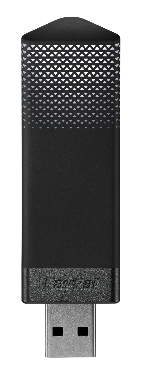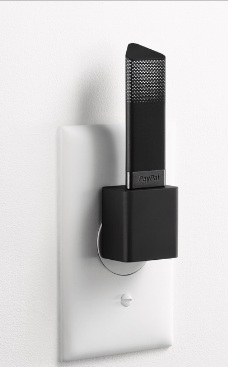One of David Marcus’s biggest challenges when taking on the role of President of PayPal was extending the platform into point of sale, and making it easier to pay with PayPal than swiping your credit card. But changing consumer behavior is an enormously difficult task. So he thought that the only thing more alluring than swiping a card is simply doing nothing when you check out of a store. Today the company is one step closer to making this a reality. PayPal is debuting Beacon, a new add-on hardware device for merchants that leverages bluetooth technology to enable consumers to pay at stores completely hands-free.
When thinking through the problem, PayPal played with geo-location leveraging GPS and Wi-Fi for iOS and Android. These technologies are what powers Square’s hands free payment system ‘Pay with Square. But they found that it ended up being a poor experience for the consumer because it sucked the batter life out of their phones.
Plus Marcus tells us that the company wanted to find a solution that would scale across point-of-sale systems.
PayPal began experimenting with Bluetooth Low Energy (aka BLE), which allows connected devices to communicate with each other while keeping the energy consumption by the devices at a very low level. Last June, PayPal recruited some of its best engineers and designers (and brought on a few hardware experts as well, says Marcus), including Mike Mettler, Hasty Granbery and Josh Bleecher Snyder to start developing the connected device. The initial goal was to develop a prototype that would leverage BLW to enable a transaction to take place without having an app running, without GPS being turned on, and even without phone signal for those places with thick concrete walls.
It’s important to note that in iOS 7, Apple is debuting iBeacon, which could provide similar services for apps. But VP of global product Hill Ferguson maintains that this does not extend to Android, and Beacon will work for any smartphone.
Beacon was developed, and started being tested on PayPal’s San Jose campus in January. So what is Beacon? Essentially it is a small hardware device, that runs on its own WiFi, plugs into an outlet and serves as a ‘beacon’ to other connected devices. Any store running compatible point of sale systems, including Erply, Leaf, Leapset, Micros, NCR, ShopKeep and Vend, will simply plug a PayPal Beacon device in a power outlet in their store, and the device can be integrated. The device itself runs updates on its own, and Granbery says that the merchant doesn’t have to touch it at all. When plugged into an outlet, the device, which takes a triangular shape similar to PayPal Here, lights up. We’re told Yves Behar, who also designed Here, was the brains behind the design of Beacon.
Consumers have to have downloaded the PayPal app, and opted into ability for retailers to use Beacon to use hands-free check-in and payments. Once this is activated, any time a consumer walks into the store the technology will trigger a vibration or sound to confirm a successful check in (this happens in milliseconds), your photo will then appear on the screen of the merchant’s Point-of-Sale system so you can be greeted by name. The app does not have to open on the consumer’s smartphone. You order or pay for your goods, and paying only requires a verbal confirmation, and the checkout is complete. A receipt will be emailed to the consumer.
 PayPal also warns that it is aware of the potential privacy issues so PayPal Beacon won’t constantly track your location unlike other technologies. If you enter a store and decline to check in, or just ignore the prompt entirely, no information is transmitted to PayPal or the merchant. PayPal has also said that there will be no ads served via the platform.
PayPal also warns that it is aware of the potential privacy issues so PayPal Beacon won’t constantly track your location unlike other technologies. If you enter a store and decline to check in, or just ignore the prompt entirely, no information is transmitted to PayPal or the merchant. PayPal has also said that there will be no ads served via the platform.
The broader vision for Beacon is to have an open platform from which merchants can create compelling, friction-less experiences for their consumers. As part of the announcement today, PayPal is giving developers access to the PayPal mobile in-store API. So for example, a drugstore could populate your prescriptions as you walk into the store so you could automatically pay for your bill without having to swipe a card. Or you could automatically add your name to a wait list for tables at a restaurant by walking in.
Marcus says that PayPal has been showing the device to retailers, large and small, and they “love it.” Part of the reason, he says, is that not only does it help them connect and potentially bring in customers, but it also integrates seamlessly with their existing point of sale systems. “I want to create an operating system for the retail environment,” he tells me.
He also adds that the company focused particularly on design. “PayPal was not a hardware company,” he says. But steadily with the debut of mobile payments device and platform PayPal Here, and now Beacon, the payments giant is definitely digging deep into hardware. He adds that this was the most sophisticated piece of hardware to ship to date and right now the company is not focused on making a profit on Beacon. PayPal says that the cost of the device has not been determined yet but it will be in the double digits.
PayPal says it will start piloting Beacon enabled shopping experiences in Q4, and the full roll-out is planned early next year.
It’s no secret Marcus has been working tirelessly to create more of a startup culture at PayPal to drive further innovation at the company. If there was anyone who could make this work, it is Marcus, who has been a serial entrepreneur until PayPal acquired his mobile payments company Zong a few years ago. He, along with the engineers I spoke to, said that this launch was much different than launches past. They all said the launch and collaboration felt more engrained in the startup culture. Not only did the team feel like what they were doing was cutting edge and unique, but written in go (code),
As evidenced by PayPal latest app update from last week, the company is making a big bet on creating an in-store experience for both consumers and retailers. It’s ambitious to say the least because not only does the payments company have to change the behavior of the consumer (from just swiping a card) but it also has to convince retailers and the 100 million plus PayPal users that it is worth it. Marcus says that providing a frictionless experience for both parties will be the key to success when changing behavior.
Stay tuned.
